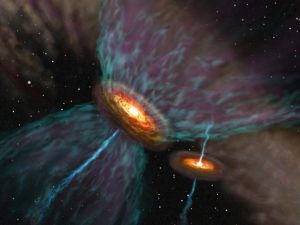Artist’s impression of UY AUR’s probable outflow system (credit: NAOJ)
Because many stars form together as companions in binary or multiple systems, investigating these systems is essential for understanding star and planet formation. Although jets (i.e., narrow bright streams of gas) and outflows (i.e., less collimated flows of gas) from single young stars are ubiquitous, only a few observations have shown jets or outflows from multiple, low-mass young stars. Therefore, the current team chose to examine the outflow structure of binary UY Aur, which is a close binary system composed of young stars separated by less than an arcsecond (0″.89).
UY Aur has a very complicated structure. Both the primary star (UY Aur A, more massive and brighter) and the secondary star (UY Aur B, fainter and cooler) have small circumstellar disks (disks of gas and material orbiting around them). In addition, a circumbinary disk surrounds the two stars. Such disks are difficult to detect, and this is only the second disk of this type that has been resolved and imaged. Receding (“redshifted”) jets have been observed, and approaching (“blueshifted”) ones have been reported for this system. However, their driving sources are not clear, because the spatial resolution of the images was too low (> one arc-second).
Credit : AAVSO

